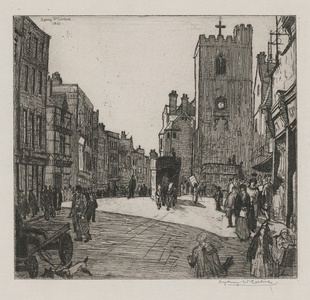| Method | Etching |
| Artist | Sydney William Carline |
| Published | 1913 |
| Dimensions | Image and plate 175 x 190 mm, Sheet 400 x 267 mm |
| Notes |
Signed in pencil. An uncommon etching by Carline, a busy scene at the bottom of the High Street looking towards Carfax Tower. Numerous pedestrians walking the pavements and a horse drawn tram heading up the High Street. Sydney William Carline (1888-1929) was a British sculptor, medallist, painter and printmaker. He was born in Oxford. Both his brother, Richard (1896-1980), and his sister Hilda (1889-1950) were also artists; with his sister marrying Richard's friend, the artist Stanley Spencer (1891-1959). The three siblings were children of the pastoral and landscape painter, George Carline (1855-1920). Between 1907 and 1910, Carline studied at the Slade School of Art, London, and was a pupil of the Royal Academician John Seymour-Lucas (1849-1923). He later studied in Paris at Percyval Tudor-Hart's Academie de Peinture. In 1913, he was commissioned by Charles Holmes, Director of the National Portrait Gallery, to cast a bronze portrait medal of the Chair of Trustees, Harold Lee-Dillon. During World War I, Carline served with his brother Richard in Italy and the Near East. He was appointed Official War Artist with the R.A.F. in 1918. His first one-man exhibition was at the Groupil Gallery in 1920; he held another exhibition there in 1929. Carline also exhibited with the London Group, becoming a member in 1924. From 1921 to 1929 Carline was Ruskin Master of Drawing at Oxford. In 1926 he contributed some illustrations to T. E. Lawrence's Revolt in the Desert. Carline lived at 3 Park Crescent, Oxford (1911) and Ford Cottage, Drayton Street, Oxford (1929). He maintained a London studio in Downshire Road, Hampstead. |
| Framing | unmounted |
| Price | £120.00 |
| Stock ID | 51979 |

